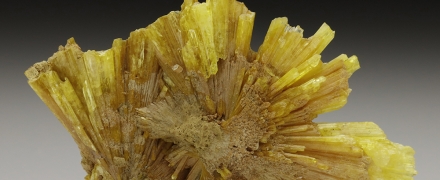open 10 am - 7 pm
laboratory is closed
Legrandite

This mineral was first discovered in samples from the Flor de Peña mine (Mexico, Nuevo Leon) collected by Louis C. A. Legrand (1861-1920), a collector and Belgian mining engineer who supervised the work at the mine. In honor of Luis Legrand, this mineral was subsequently named. Although legrandite is poisonous (hydroxoarsenate zinc), but in view of the fact that it is sometimes found in the form of well-formed crystals, moreover, having a fairly bright color in shades of yellow, its druses, brushes and individual crystals are used as decorative collection material. And given its not the lowest hardness of 4.5 - 5 (on the Mohs scale), collection cuts are made from transparent crystals that have not found use as a collection material. Of course, wearing such a stone in a product is not a good idea, given its toxicity, not high hardness and brittleness. But faceted stones look great in the gemological collection. A small number of cut stones weighing over 1.00 carats makes this stone quite rare and expensive find for the gemologist collector. Stones suitable for cutting and having a fairly large size usually come from Mexico, Namibia, and (rarely) from the pegmatites of Brazil (Minas Gerais).
В геммологической практике бывают весьма увлекательные случаи с диагностикой ювелирных вставок
Но помимо редкости цвета и высокой стоимости таких камней, многие розовые камни выделяются одной замечательной особенностью – они проявляют плеохроизм, то есть в зависимости от положения осмотра камня он может иметь дополнительные оттенки – оранжевый или пурпурный.
Currently, gemstones are produced by two fundamentally different technological methods - the High Pressure - High Temperature method (“HPHT”, High-pressure & High-temperature) and the Chemical Vapor Deposition (“CVD”, Chemical vapor deposition) method. The "HPHT" method is the most tested classical synthesis method, which can be used both carbon deposition on diamond from flux melts and catalytic reactions. In "CVD" synthesis, diamond growth occurs on a seed during carbon deposition mainly from a gaseous medium at relatively low temperatures and pressures.
Jewelry and precious stones are just such a category of goods, when buying which you need to pay attention to many criteria.
Sogdianite is a rather rare mineral and more often it can be found as a collection material (moreover, in systematic collections), and it is extremely rare in jewelry.






